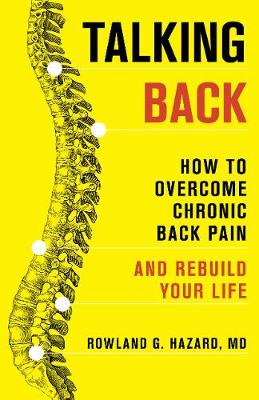
annieb123
Written on May 22, 2021
Talking Back is a practice based layman accessible monograph on chronic back pain by Dr. Rowland G. Hazard. Published 7th May 2021 by Rowman & Littlefield, it's 160 pages and is available in hardcover and ebook formats.
This is a well written and engaging book written with people in mind who are living with chronic pain and are struggling to find diagnoses, coping mechanisms, and/or ultimately improve their mobility and quality of life. The information is related in the form of general case studies (mosaics of lots of patients from similar situations) in a group treatment setting, which the author refers to as FRP (Functional Restoration Programs). The "patients" he discusses and their situations are believable and definitely compassionately rendered and relatable.
The book is strong on background and analysis. The author spends quite a lot of time discussing the differences in patient perception of pain, function, and treatment outcomes. He also does a decent job of allowing the reader to think about their own pain and how (and when) it presents and help for beginning the dialogue which needs to happen for patients to begin their own recovery, and even planning for discussing with their practitioner(s) about practical concrete goals and how to begin to realize them.
The book is a good tool for advocacy. After reading it, patients will have some idea of potential new avenues to try, new options for diagnostic tools, and how to bridge the gap between trying to explain one's own case history to (yet another) healthcare professional and get them to really *listen* to what is being explained.
What is not really within the scope of the book is concrete treatment/workout routines or physical exercises to combat pain or helpful coping mechanisms. It is *not* a how-to book. It wouldn't be logical (or medically responsible) to write down "one-size-fits-all" physio exercises and call it a day. What would be helpful and therapeutic for one patient would be potentially catastrophic for another.
I did like that despite being fictionalized, the author included an epilogue with the outcome for each of the patient cases included in the group sessions in the book. Even though they weren't all happy, it gave the book a more realistic feel.
This would be a worthwhile read for patients going through the medical system carousel right now and who aren't feeling heard or helped. It would also be a good choice for friends or family of chronic pain patients who are fulfilling the role of patient advocate.
Four stars. The author has also included a good selection of links and resources for further reading.
Disclosure: I received an ARC at no cost from the author/publisher for review purposes.
